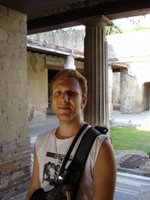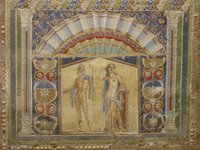
 Holy moley, Pompeii is seriously huge. It's some 66 hectares of Roman city laid out in a large semi-rectangular shape, which was buried by the eruption of Mt Vesuvius in 79AD. Following the excavations, you can now walk around the largely preserved city and get a sense of what it was like to live in those, comparatively modern, times.
Holy moley, Pompeii is seriously huge. It's some 66 hectares of Roman city laid out in a large semi-rectangular shape, which was buried by the eruption of Mt Vesuvius in 79AD. Following the excavations, you can now walk around the largely preserved city and get a sense of what it was like to live in those, comparatively modern, times.There are cobbled streets, with ruts formed by the chariot wheels. There are street hoardings, 'for rent' notices, graffiti and water fountains. There are small food shops that look like Asian fast food joints. You can walk into houses and see them almost as they were, with the invidual rooms complete with floor mosaics and painted walls. We explored public baths, patrician villas (large holiday homes outside the city walls), temples, the local government buildings, a brothel, necropoli (graveyards), theatre complexes (with atrium and galdiator's barracks) and the massive stadium and nearby exercise yard.
 After many hours here, we caught a train to Herculaneum. This was more of a seaside resort and, thanks to the mud that filled it (Pompeii was hit by pumice rocks and ash), is even better preserved than Pompeii.
After many hours here, we caught a train to Herculaneum. This was more of a seaside resort and, thanks to the mud that filled it (Pompeii was hit by pumice rocks and ash), is even better preserved than Pompeii.Herculaneum is set well below the street level of modern Ercolano (from all accounts, a bit of a slum). It is set in a massive recessed pit, which you reach either by tunnel or bridge. Here there are more complete mosaics in situ, and there are lovely gardens that have been replanted. It is a useful companion site to Pompeii - and if you only had a little time, would probably be a sufficient visit. Kind of like Pompeii's finest compressed into a small site, though it doesn't give the sense of scale.
 A long day for us, so back to Naples for more exquisite pizza and beer!
A long day for us, so back to Naples for more exquisite pizza and beer!
No comments:
Post a Comment